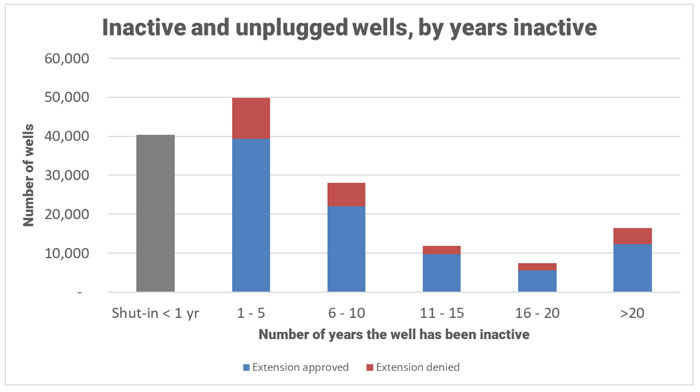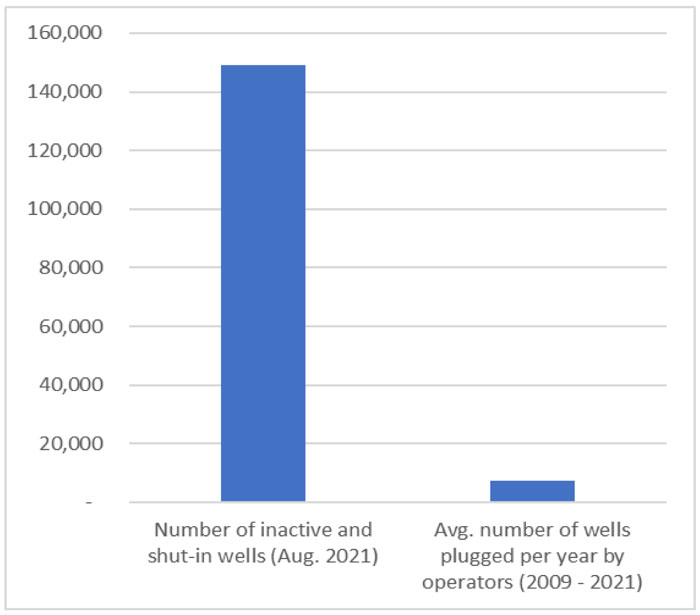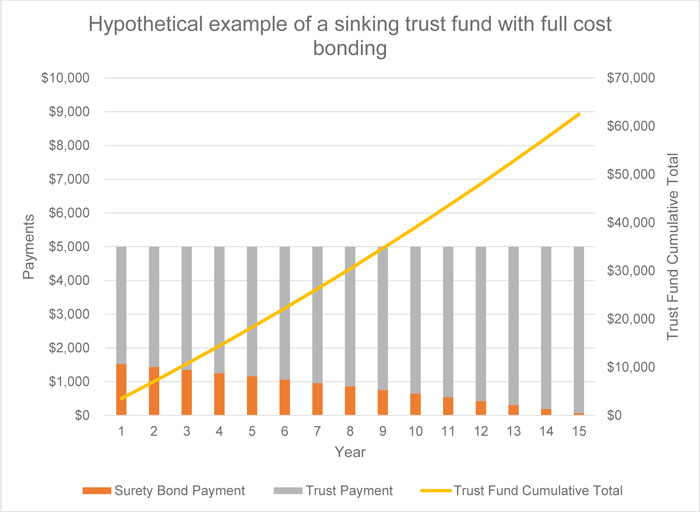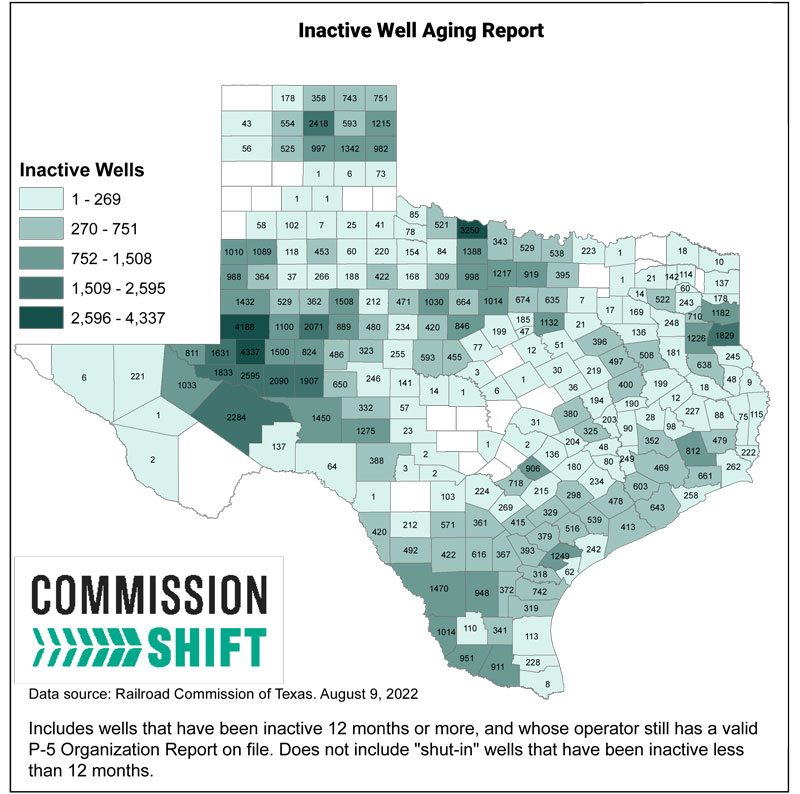Commission Shift is a statewide nonpartisan nonprofit organization focused on building public support to reform oil and gas oversight in Texas. In January, we published a report in which we summarized the Railroad Commission’s data on abandoned wells and sources of revenue to the oil and gas regulation and cleanup fund.[1] Today, I will highlight three solutions among many offered in the report to help reduce problems caused by abandoned oil and gas wells in Texas: (1) reducing inactive well plugging extensions; (2) requiring full cost financial assurance; and (3) clarifying the definition of orphaned wells.
The slow pace of well plugging and cleanup by both operators and the Railroad Commission has led to water pollution, road damage, and dangerous blowouts across the state.[2] Even as the oil and gas industry has reported record profits this year, jobs have not rebounded to pre-pandemic levels.[3] By requiring full cost financial assurance and reducing inactive well plugging extensions now, you can help put oil field workers back to work protecting generations of Texas families and the natural resources we depend on.
The commission plugs an average of 1,600 wells per year,[4] and still has a growing list of orphaned wells numbering nearly 8,000.[5] Federal taxpayer funds from the Bipartisan Infrastructure Law will only cover about 7,000 wells, and new orphans will be added to the list in the future. The problem is state law allows operators many ways to qualify for well plugging extensions year after year.[6]
This has led to a pileup of 150,000 shut-in and inactive wells across Texas (Figure 1). Operators only plug about 7,000 wells each year (Figure 2).[7] At this rate, it would take about 21 years to plug all the inactive and shut-in wells.
At the highest tier of blanket bonding, operators contribute only $2,500 per well to the commission’s well plugging costs, sometimes less. The average well plugged by the Railroad Commission costs 16 times more to plug.[8], [9] Requiring full-cost bonding in combination with a sinking trust fund (Figure 3), would guarantee that funds would be available to plug and clean up well sites after the wells reach their economic limit.
Finally, statute defines orphaned wells broadly (see p. 5 below),[10] but the commission has interpreted the definition of orphaned wells to exclude P-13’d wells that were reclassified as water wells.[11] Explicitly including wells reclassified as water wells in the definition of orphaned wells would allow the commission to use federal or state funds to cleanup major pollution sites related to oil and gas development that landowners and local jurisdictions cannot afford to deal with.
Ultimately, any strategy the legislature takes should include a goal to eliminate the future threat of unplugged wells in Texas. These wells are causing multi-generational problems that our families will endure if the legislature doesn’t act. Thank you for your time and consideration.
FIGURE 1: INACTIVE WELLS

Source: Railroad Commission of Texas. Inactive Well Aging Report (Aug 9, 2022) and Wells Monitored by the Railroad Commission (July 31, 2022).
Note: The Railroad Commission’s August 9th Inactive Well Aging Report indicated that the commission denied plugging extension requests for more than 24,000 wells on the list. Considering that operators plug an average of 7,000 wells per year, it is unlikely that all 24,000 wells will be plugged within the next 12 months.

Source: Railroad Commission of Texas. Wells Monitored by the Railroad Commission. (8/31/2021). and Oilfield Cleanup Program Annual Reports.

Note: Assumes a total decommissioning cost of $65,000, an initial trust payment of $2,500, a surety bond rate of 2.5%, and a 15-year term.
“(3) “Orphaned well” means a well:
(A) for which the commission has issued a permit;
(B) for which production of oil or gas or another activity under the jurisdiction of the
commission has not been reported to the commission for the preceding 12 months; and
(C) whose operator’s commission-approved organization report has lapsed.”


[1] Biven, M. M., & Palacios, V. (2022). Eliminating Orphan Wells and Sites in Texas: A Toolkit for Redesigning the Railroad Commission’s Oil and Gas Well Plugging and Cleanup Programs. Commission Shift. https://commissionshiftaction.org/orphan-wells/
[2] Boehmer Lake, Antina Ranch, Crane County Geyser, Sinkhole on FM 1053, Well blowout on Molly Rooke’s ranch in Refugio County, orphan and legacy well contamination on Schuyler Wight’s ranch in Pecos County.
[3] Mike Lee. (2022, July 27). ‘Not the same oil industry.’ Record profits don’t create jobs. E&E News.
https://www.eenews.net/articles/not-the-same-oil-industry-record-profits-dont-create-jobs/
[4] Data from 2007 to 2021 compiled by Commission Shift from the Railroad Commission’s Oil Field Cleanup Program Annual Reports. Retrieved from: https://www.rrc.texas.gov/oil-and-gas/environmental-cleanup-programs/oil-gasregulation-and-cleanup-fund/
[5] Railroad Commission of Texas. (July 31, 2022). Orphan Wells With Delinquent P-5 Greater Than 12 Months. Research and Statistics. https://www.rrc.state.tx.us/oil-and-gas/research-and-statistics/well-information/orphanwells-12-months/
[6] Tex. Nat. Res. Code Sec. 89.023
[7] Railroad Commission of Texas. (Apr. 30, 2022). Well Distribution Tables. https://www.rrc.texas.gov/oil-andgas/research-and-statistics/well-information/well-distribution-tables/ also see Biven and Palacios (2022) at p. 16, Figure 8.
[8] Cost Calculation, Plugging Cost Estimates, Railroad Commission of Texas, https://www.rrc.texas.gov/oilgas/compliance-enforcement/hb2259hb3134-inactive-well-requirements/cost-calculation/ and Legislative Appropriations Request Fiscal Years 2022-2023, Railroad Commission of Texas, 59, https://www.rrc.state.tx.us/media/59717/lar-2022-2023.pdf.
[9] “American ‘backyard’ wells, the flexible 11% of US onshore oil output, now face an inflexible choice,” Rystad Energy, March 31, 2020, https://www.rystadenergy.com/newsevents/news/press-releases/american-backyard-wellsthe-flexible-11pct-of-the-us-onshore-oil-output-now-face-an-inflexible-choice/
[10] Tex. Nat. Res. Code Sec. 89.047 (3)
[11] AdminMonitor. April 12, 2022. Railroad Commission of Texas Open Meeting. See Public Input section beginning at 24:39. Retrieved from: https://www.adminmonitor.com/tx/rrc/open_meeting/20220412/